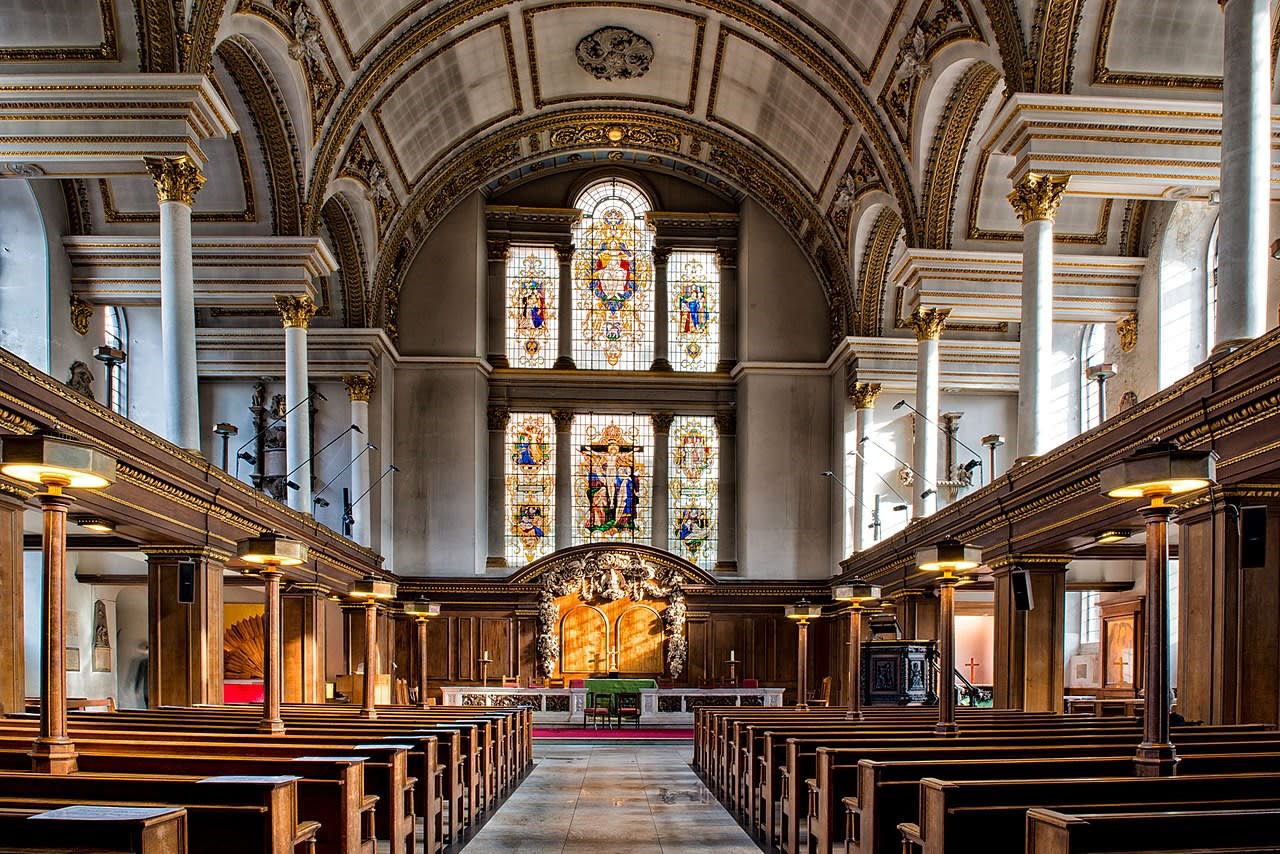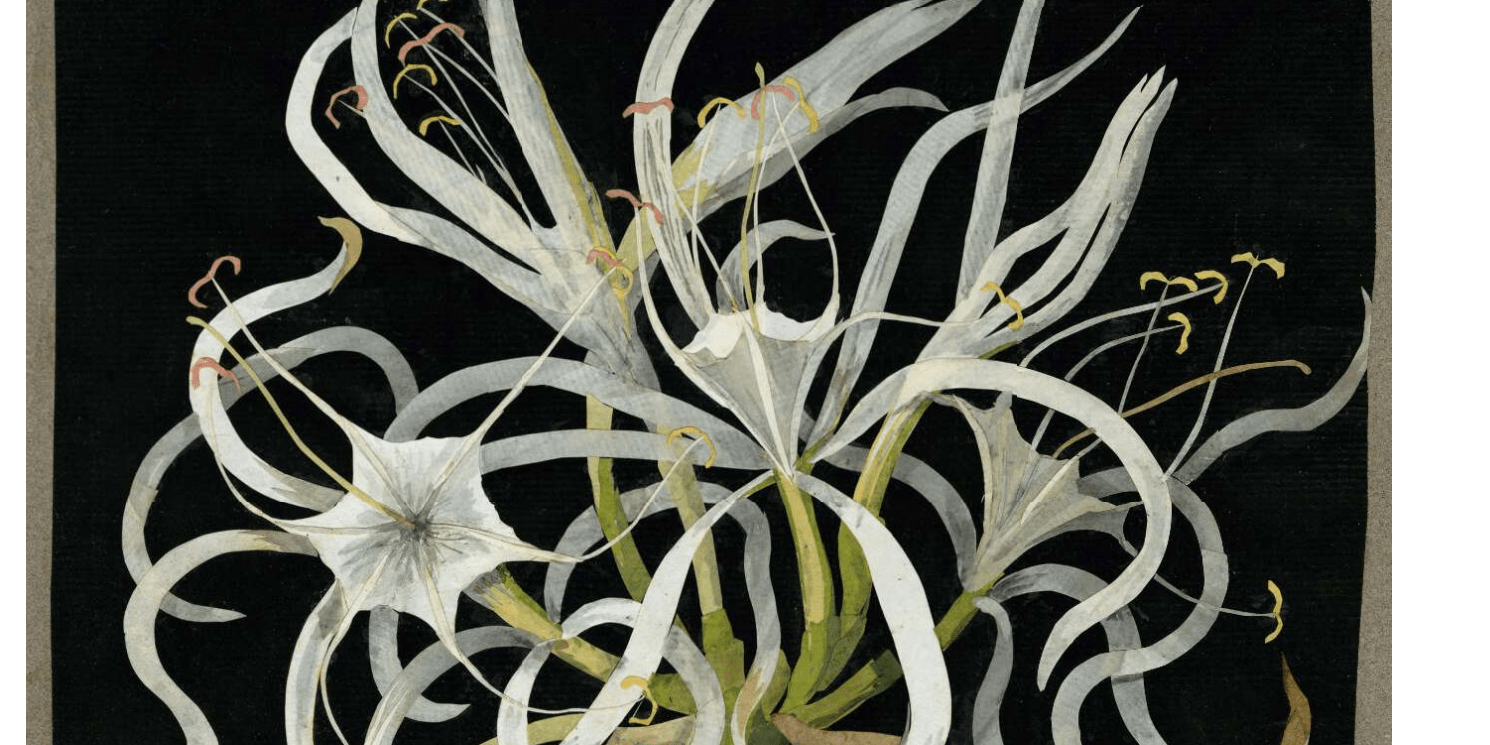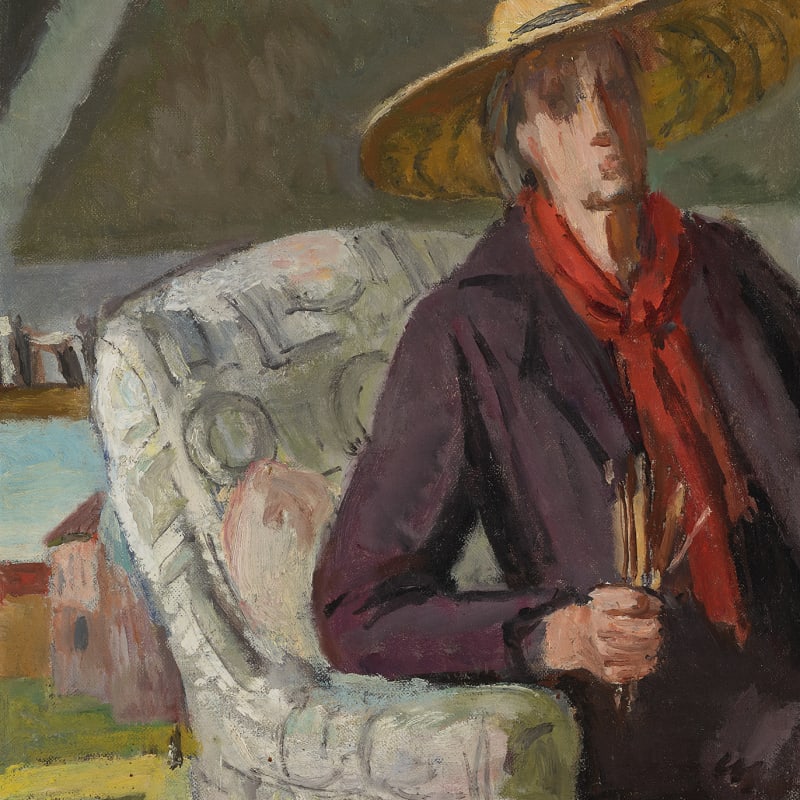The route from Philip Mould & Co. to the Royal Academy is one of my favourite and most familiar walks in London. Walking down the side of the gallery and into St James's Square is the perfect way to avoid the busy thoroughfares of Waterloo Place and Piccadilly. The little park that emerges is beautiful at all times of year but particularly in autumn when every tree is ablaze and systematically lit by bright white sunshine passing over the rooftops (when I think of St James's Square it is always sunny). If you cross the gardens to Duke of York Street, you might like to take a moment to look at the English Heritage blue plaque that marks Ada Lovelace's house at 12 St James's Square, the nineteenth-century mathematician and computing pioneer. If you don't know anything about Ada Lovelace then I suggest you join the London Library, just two doors down at number 14, to find out more.
As you walk up Duke of York Street, you are confronted by an austere brick building, St James's Church Piccadilly, designed by Christopher Wren and consecrated in 1684. In the rain this church provides the perfect indoor cut-through to Piccadilly and the RA, but today this church is our destination. The interior boasts some of Grinling Gibbons' most accomplished marble and limewood carvings, and given the church's position on the periphery of Mayfair and St James's, it is no wonder that it has been closely associated with the surrounding artistic community since its completion. Angelica Kauffman, one of the founders of the Royal Academy, was married here in 1767, and the number of artists buried and memorialised both inside and outside the church is staggering.[1] Plaques and gravestones marking the achievements of male artists dominate and include: James Gillray, James Jebusa Shannon, George Spencer Watson, Willem Van De Velde (both elder and younger) and William Blake, but there are also two women artists memorialised inside the church who deserve greater recognition. This topic feels particularly poignant in Lucy Winkett's tenth year as Rector of St James's church. She is the first and only woman to hold the position, and was the first woman priest to be appointed to St. Paul's Cathedral - a position that, even in the 2000s, was sadly marred by misogyny.
The two Marys memorialised in St James's Church, Piccadilly are Mary Beale (1633-1699), the successful seventeenth-century portraitist, and Mary Delany (1700-1788), an artist who invented a form of paper-cutting called decoupage. Although these two women never met - Mary Delany was born seven months after Mary Beale's death - both women produced substantial oeuvres that were popular amongst their upper-class contemporaries. Both women successfully negotiated the limitations inherent to their sex and, until relatively recently, their memorials in St James's Church were either absent or unidentifiable in their artistic achievements. Mary Beale's tomb was destroyed in the Second World War and it was only in the last few years that a plaque was presented to the church to mark her burial and her profession as a portraitist. Mary Delany's memorial is mounted in the wall of the north aisle just below Beale's, but it fails to recognise her achievements as an artist and only records that she was a daughter, a wife (twice) and that 'she was a lady of singular ingenuity and politeness and unaffected piety.'
From an expanding body of literature on Mary Delany, including Clarissa Campbell Orr's most recent biography published in October 2019, we can determine that she was a stronger and more defiant individual than her memorial gives credit. Born Mary Granville, Delany was a well-educated woman who spoke several languages and was accomplished in art, music and embroidery. Although her education was typical of that undertaken for a life at Court, she also held progressive views on women's education and marriage, and queried whether women should marry at all.[2] She can be recognised as a feminist, although the word was not invented until the late nineteenth-century.
With a decline in the Granville family fortune, Mary was married off at the age of seventeen to Alexander Pendarves, a Member of Parliament who was forty years her senior.[3] This proved to be an unhappy marriage but it was at their home near Falmouth in Cornwall that Mary began to develop an interest in shells and flowers that would last a lifetime. Pendarves died in 1724, leaving the twenty-four-year-old Mary a widow. Mary did not inherit the majority of her husband's wealth, in favour of Pendarves' nephew. However, her widow's pension saw to her independence and instead of marrying again (it was said that Mary had eight marriage proposals during her lifetime) she chose to stay single and thrived in a society of close female friends, until her second marriage at the age of forty-three.[3]
Patrick Delany, an Irish cleric, and friend of the writers Sheridan and Swift, was an unusual choice for Mary who had lived for several years enjoying her independence as an unmarried woman. However, the pair shared a love of nature and Delany was described as a kind, humorous and clever man.[5] After their marriage, Mary and Patrick moved to Dublin, to a small estate called Delville, where Mary fondly named their herd of deer after members of her family.[6] Following Patrick’s death in 1768, Mary she returned to England at the age of sixty-eight and became a companion to her close friend Margaret Harley, the Duchess of Portland. The two women lived for six months of the year at Bulstrode in Buckinghamshire, where Mary improved the gardens and began to collect botanical specimens. It was only at this point in her life, from the age of seventy, that she began to produce a substantial oeuvre of flower art, which Mary called ‘paper mosaiks’.
Mary began her Flora Delanica in 1771. This involved collecting flower specimens and then dissecting them in order to understand their construction. She then sourced a variety of delicate, coloured tissue paper which she intricately cut by eye – there is no evidence that she drew or planned these compositions first. She then arranged the pieces of paper into flawless imitations of the flowers – a paper ‘hortus siccus’.[7] She would highlight some of these collages with watercolour and others she would simply stick to the black backing paper with either flour and water or possibly egg whites.[8] In total, Mary produced 985 examples of her ‘paper mosaiks’ and meticulously labelled each paper flower with the plant’s Linnaeum and common names. She produced, on average, a hundred pages a year until her eyes began to fail and she stopped working in 1784. The detail of these flowers was described by Joshua Reynolds as ‘unrivalled in perfection and outline and delicacy of cutting.’[9] Mary’s work can be seen in the British Museum where the collection was donated by her great-niece Augusta Hall, Baroness Llanover in 1897.[10]
There is no doubt that Mary Delany was tremendously talented which begs the question, what could she have achieved as a professional artist, had she been encouraged and trained alongside her male contemporaries? We should also ask, why has she been overlooked as a serious and skilled artist for so long? One of the reasons for her oversight is that the art of paper cutting, particularly paper flowers, has been construed as a female subject of artistic expression, and therefore is deemed less valuable. A second reason is that Mary Delany was a woman who came into her own in her seventies, an age when society (both then and now) sees women as redundant, superfluous and with very little to offer the modern world. Mary Delany has proved that this attitude is incorrect.
It is also important to note that in the eighteenth-century flower painting, or crafting, was a way to ‘involve herself in speculative and scientific matters – manly things – in a lady-like way.’[11] At Bulstrode, Mary worked alongside many visitors including the botanical artists George Dionysius Ehret, Joseph Banks, and Daniel Solander who became reliant on Mary’s accurate recreations for their own work. [12] When the Duchess of Portland died in 1785, Mary, at the age of eighty-five, had attracted the attention of Queen Charlotte, who gave her a royal cottage at Windsor to live in for the last three years of her life. Although Mary Delany had been well-known for her ‘paper mosaiks’, she was buried in relative obscurity and her artistic identity at St James’s Church was never recorded.[13]
Mary Beale, the second Mary buried at St James’s Church, is better remembered. She was a successful portraitist during her lifetime, and there is a significant body of literature on her life and work. It is not known how Beale learnt to paint. Perhaps her father taught her or she commenced as a gifted amateur; it has even been suggested that she was taught by Peter Lely (later the painter to Charles II) or Robert Walker.[14] Her portraits exist in international collections, with one of her most accomplished self-portraits, holding an unfinished canvas of her two sons, in the National Portrait Gallery in London. However, Mary Beale is still not a household name which, considering her monumental achievements as a woman working professionally as an artist in the seventeenth century, should be surprising.
A married gentlewoman in the seventeenth-century was expected to be 'deferential, modest and virtually silent', three characteristics that thankfully cannot be attributed to Mary Beale.[15] On the 14th August 1663, she wrote Observations by MB on how best to paint apricots. Helen Draper stated in her article '"Her Painting of Apricots": The Invisibility of Mary Beale (1633-1699)' that this is the first known text in English to explain the practice of painting by a female artist, and one of the earliest writings on this subject by either gender.[16] These observations are far from modest and are an authoritative voice on fine art. Beale is overtly advertising her skill as a painter through words.
What is even more interesting is that Beale wrote Observations in the back of her husband's notebook, which not only demonstrates his support for her work, but also assumes a wider readership beyond her own personal diary - perhaps she wrote this to instruct her sons or her studio assistants, or even for future scholars analysing her work.[17] Charles Beale, Mary's husband, had started this notebook to record his own artistic experiments from 1647/8, prior to his marriage to Mary in 1652. Charles was a civil service clerk who, after seeing his wife's talent and her potential to paint professionally, gave up his job to become Mary's studio manager. The notebook in which Observations is written, not only shows a husband and wife's collaboration and the pooling of their expertise, but it can also be perceived as an act of social defiance. This last entry is indicative of Mary exceeding her husband's artistic interests - his submission - and his loving encouragement for his wife's skill. It is recorded in the 1680s that Charles Beale was shopping for clothes for his children and servants, whilst his wife was at home painting as the breadwinner.[18]
Women in the seventeenth century were expected to live a domestic life, running the household and producing children; so how did Mary Beale negotiate the expectations of her society to develop a successful and professional portrait practice? Throughout the 1660s she was painting friends and family. She wouldn’t have been able to paint strangers in her house, particularly men, for fear it would be misconstrued.[19] In order to preserve her reputation and become a professional artist with a wider client base, Mary and her husband Charles had to slowly and carefully widen their social circle to include an increasing number of potential clients. By building a rapport with unknown individuals and acquaintances, Mary could then invite them at a later date to her studio on Pall Mall to have their portrait painted. Although there had been a number of women painters and patrons as early as the 1500s, it would have been a difficult and laborious process to attract well-off clients and establish a prosperous business as a female portraitist in the latter half of the seventeenth century.[20]
Beale became a leading portraitist in 1670 and was the matriarch of her business and family. Charles worked as her studio manager and assistant, and systematically experimented with different pigments and drying times for his wife. Both of Mary’s sons, Bartholomew and Charles, also helped in the studio painting the drapery and backgrounds of their mother’s portraits. Finally, in 1681, Mary employed a female student, Keaty or Kate Trioche, to work with her in the studio, followed by Sarah Curtis from Pontefract, Yorkshire in 1691. Unfortunately, little is known about Kate Trioche but Sarah Curtis continued to practise portraiture professionally with some success for at least twenty-five years after her marriage.[21] In May 1701, Sarah Curtis, part of a new generation of female portrait painters, married Benjamin Hoadly in St James’s Church Piccadilly; the same church where her influential teacher, Mary Beale, had been buried two years before, and where her memorial now lies.[22]
[1] Wendy Wassyng Roworth, Kauffman, (Anna Maria) Angelica Catharina (1741–1807), history and portrait painter (Oxford University Press, 2009), accessed doi:10.1093/ref:odnb/15188.
[2] C C Orr, Mrs Delany: A Life (Yale University Press, 2019), 2-3.
[3] Viola Barrow, ‘Mary Delany 1700-1788’, Dublin Historical Record 42, no. 3 (7 November 1989): 106–107. Lisa L Moore, ‘Queer Gardens: Mary Delany’s Flowers and Friendships’, Eighteenth-Century Studies 39, no. 1 (7 November 2005): 51.
[4] C C Orr, Mrs Delany: A Life (Yale University Press, 2019), 2-3.
[5] Barrow, ‘Mary Delany 1700-1788’, 108.
[6] Barrow, ‘Mary Delany 1700-1788’, 110.
[7] Barrow, ‘Mary Delany 1700-1788’, 111.
[8] Barrow, ‘Mary Delany 1700-1788’, 112.
[9] Barrow, ‘Mary Delany 1700-1788’, 112.
[10] ‘Mary Delany’, British Museum Online, accessed 7 November 2020 https://www.britishmuseum.org/about-us/british-museum-story/people-behind-collection/mary-delany.
[11] Ann Bermingham, Learning to Draw: Studies in the Cultural History of a Polite and Useful Art (New Haven: Yale University Press, 2000), 224. Moore, ‘Queer Gardens: Mary Delany’s Flowers and Friendships’, 67.
[12] Moore, ‘Queer Gardens: Mary Delany’s Flowers and Friendships’, 61.
[13] Moore, ‘Queer Gardens: Mary Delany’s Flowers and Friendships’, 51.
[14] Helen Draper, ‘“Her Painting of Apricots”: The Invisibility of Mary Beale (1633–1699)’, Forum for Modern Language Studies 48, no. 4 (1 October 2012): 393.
[15] Helen Draper. ‘“Her Painting of Apricots”: The Invisibility of Mary Beale (1633–1699)’, 389.
[16] Helen Draper. ‘“Her Painting of Apricots”: The Invisibility of Mary Beale (1633–1699)’, 389.
[17] Helen Draper. ‘“Her Painting of Apricots”: The Invisibility of Mary Beale (1633–1699)’, 390.
[18] Helen Draper. ‘“Her Painting of Apricots”: The Invisibility of Mary Beale (1633–1699)’, 401.
[19] Helen Draper. ‘“Her Painting of Apricots”: The Invisibility of Mary Beale (1633–1699)’, 392.
[20] Susan James, Feminine Dynamic in English Art, 1485–1603 (Farnham: Ashgate, 2009).
[21] Judy Egerton, Hoadly [née Curtis], Sarah (1676?–1743), portrait painter (Oxford University Press, 2004), accessed doi:10.1093/ref:odnb/13379.
[22] W Gibson, Enlightenment Prelate: Benjamin Hoadly, 1676-1761 (James Clarke & Company, 2004), 53.
Lydia Miller
Lydia is currently working on her PhD at the University of York and is Assistant Curator, Cross-Collections at the National Portrait Gallery.
Bibliography
Barrow, Viola. ‘Mary Delany 1700-1788’. Dublin Historical Record 42, no. 3 (7 November 1989): 106–13.
Bermingham, Ann. Learning to Draw: Studies in the Cultural History of a Polite and Useful Art. New Haven: Yale University Press, 2000.
Draper, Helen. ‘“Her Painting of Apricots”: The Invisibility of Mary Beale (1633–1699)’. Forum for Modern Language Studies 48, no. 4 (1 October 2012): 389–405. Accessed doi:10.1093/fmls/cqs023.
Egerton, Judy. ‘Hoadly [Née Curtis], Sarah (1676?–1743), Portrait Painter’. Oxford University Press, 2004. Accessed doi:10.1093/ref:odnb/13379.
Gibson, W. Enlightenment Prelate: Benjamin Hoadly, 1676-1761. James Clarke & Company, 2004.
James, Susan. Feminine Dynamic in English Art, 1485–1603. Farnham: Ashgate, 2009.
‘Mary Delany’. British Museum Online. Accessed 7 November 2020 https://www.britishmuseum.org/about-us/british-museum-story/people-behind-collection/mary-delany.
Moore, Lisa L. ‘Queer Gardens: Mary Delany’s Flowers and Friendships’. Eighteenth-Century Studies 39, no. 1 (7 November 2005): 49–70.
Orr, C C. Mrs Delany: A Life. Yale University Press, 2019.
Roworth, Wendy Wassyng. ‘Kauffman, (Anna Maria) Angelica Catharina (1741–1807), History and Portrait Painter’. Oxford University Press, 2009. Accessed doi:10.1093/ref:odnb/15188.








